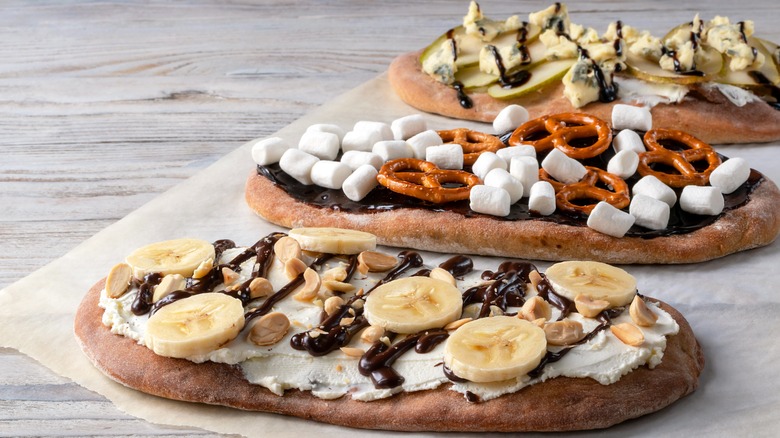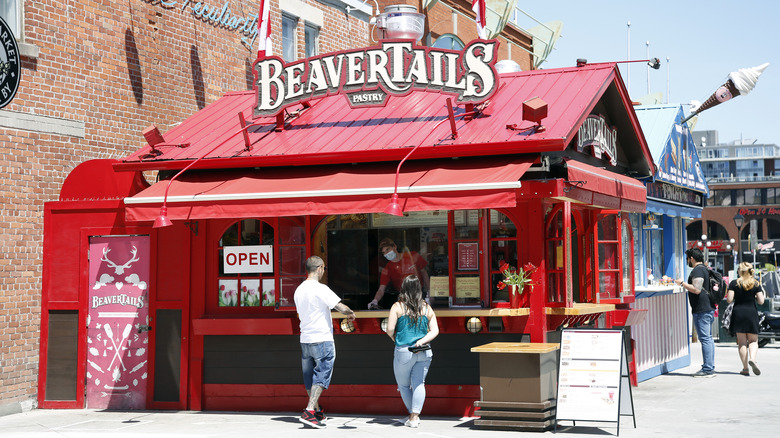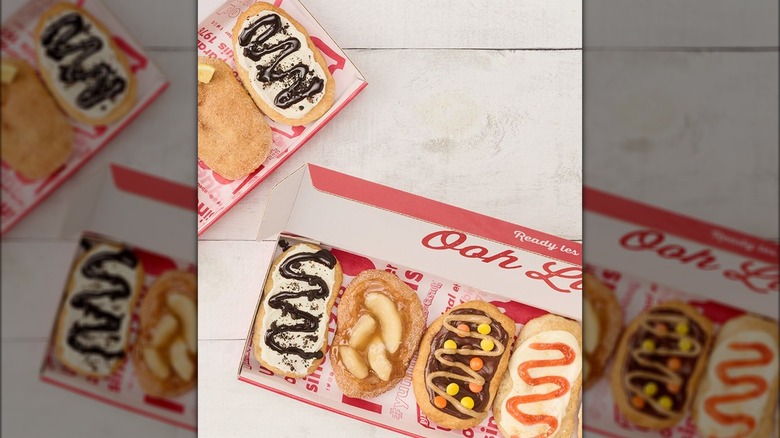Beaver Tails Are The Canadian Delicacy You Need To Know About
Before we say anything, let it be known that the Canadian confections called beaver tails are not made using actual beavers. This is not to say that eating beavers is an unusual practice. Real beavertails are a delicacy long enjoyed by indigenous peoples, and are an excellent source of fat, which is crucial for survival in freezing conditions. The beaver tails we're talking about, though, are oval-shaped, deep-fried discs of dough served with an array of toppings, from a simple sprinkling of cinnamon and sugar to chocolate, fruit, and candies.
So what makes beaver tails, known in French as "queues de castor," different from other forms of fried dough? Well, "BeaverTails" is actually a restaurant chain and registered trademark owned by a Canadian company that began slinging fried dough in 1978. With stores spread throughout Canada, with other locations in the United States, Japan, France, and the United Arab Emirates, BeaverTails is serving up these sweet treats around the globe.
The aforementioned company may own the "beaver tails" name, but if you fry up some discs of dough and add delicious toppings, you'll essentially be enjoying the same thing (just don't try to sell them under the copyrighted term). Typically, these treats are served sweet, but savory beaver tails exist as well. In fact, if you head to a BeaverTails store, you can get your order topped with poutine.
Where did beaver tails come from?
The tale of beaver tails begins similarly to that of other humble, beloved regional foods. Pam and Grant Hooker started making and selling a family pastry recipe in 1978 at a fair in Killaloe, Ontario. They called them "beaver tails" because of the long, flat shape that resembled the large tail of the animal. The original recipe came from Grant's German grandmother, who topped her own fried pastries with butter, jam, honey, or cinnamon sugar and served them as breakfast pastries.
By the 1990s, the Hooker family had opened shops selling their pastries in several locations in Quebec, and had begun franchising their brand. Soon, more shops were opening up in other parts of Canada. In 2015, BeaverTails become an international business. Each BeaverTails shop makes the pastries the same way: Whole wheat dough is pulled and stretched into an elongated shape before it's fried until browned and crisp. The available toppings are also consistent from shop to shop, to maintain uniformity and quality control.
Of course, beaver tail-like pastries not made by the company are also delicious, and customizable, to boot. Some copycat recipes recommend savory toppings like garlic butter and cheese, while others follow in the sweet footsteps of the BeaverTails menu. Apple pie filling, Oreos, cheesecake spread, strawberry jam, and more appear on the chain's pastry selection.
Where to get BeaverTails in America
Beaver tails have joined the ranks of iconic Canadian foods, alongside poutine and Canadian bacon, which is also called "back bacon" or peameal bacon in the Great White North. These pastries might be mistaken for another Canadian specialty called Bannock. This simple fry bread originated in Scotland, but made its way to Canada and became popular among indigenous peoples. It can be deep-fried, but is often baked in an oven. Unlike a beaver tail, Bannock doesn't come with toppings and is simple enough to prepare over a campfire in the wilderness. It may be flat like a beaver tail, but its simplicity and complete lack of sugar makes it wholly different.
To experience an actual BeaverTail in the United States, you'll need to make your way to one of three locations: Fayetteville, Arkansas; Farmington, Utah; or Dollywood amusement park in Tennessee. The most popular flavors to order include the Killalou Sunrise, which tops the warm pastry with cinnamon sugar and a bright squeeze of lemon, and the Triple Trip, which is doused in chocolate hazelnut spread, peanut butter, and Reese's Pieces. Of course, you can make your own large, fried donuts at home and top them with whatever you like. It's like a funnel cake or churro, but uniquely Canadian.



